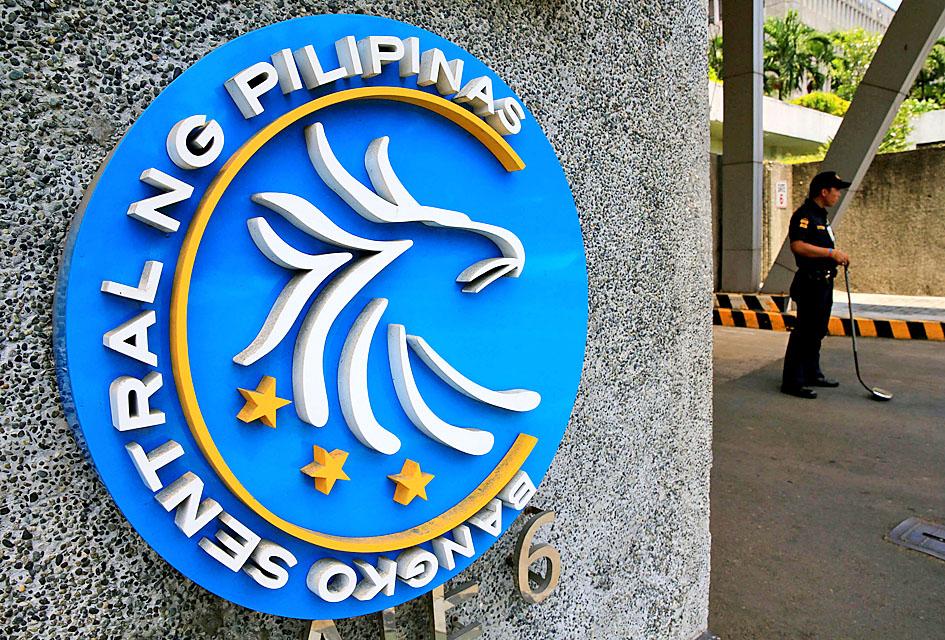The Philippine central bank yesterday raised interest rates for the second time in two months, warning that inflation would breach its target this year with rising commodity prices and fish shortages driving up costs.
The monetary authority hiked its key interest rate by another 25 basis points to 2.5 percent, effective today.
Bangko Sentral Governor Benjamin Diokno said the central bank was prepared to “take all necessary policy action” to bring down inflation over the medium term.

Photo: Reuters
Overnight deposit and lending facilities were raised by the same amount to 2 percent and 3 percent respectively.
The hike comes after inflation hit 5.4 percent last month, the highest level in more than three years as steep oil price increases pushed up food prices and transport costs. Inflation is expected to reach 5 percent this year and 4.2 percent next year, exceeding the central bank’s target range of 2 to 4 percent.
The second consecutive increase enabled policymakers to withdraw stimulus measures while safeguarding economic stability, Diokno said.
Separately yesterday, Norway’s central bank announced a sharper-than-expected interest rate increase, and warned of more hikes to come, as policymakers tighten monetary policies worldwide to fight surging inflation.
The central bank raised its main rate by 0.5 percentage points to 1.25 percent, its fourth hike since September, when it stood at zero.
The previous increases had been of 0.25 percentage points each and few analysts had predicted yesterday’s sharper hike.
“Prospects for a more prolonged period of high inflation suggest a faster rise in the policy rate than projected earlier,” Norges Bank Governor Ida Wolden Bache said in a statement.
“A faster rate rise now will reduce the risk of inflation remaining high and the need for a sharper tightening of monetary policy further out,” she added.
To curb inflation, the bank is to accelerate the tightening of its monetary policy and expects its rate to reach “3 percent in the period to summer 2023.”
The rate is “most likely” to rise to 1.5 percent in August, based on the bank’s “current assessment of the outlook and balance of risks,” Wolden Bache said.
Consumer prices in Norway reached 5.7 percent year-on-year last month and core inflation, excluding energy prices ---- the indicator used by Norges Bank ---- was 3.4 percent, or well above its official monetary policy target of about 2 percent.
However, Turkey’s central bank yesterday once again bucked global trends and kept its benchmark interest rate stable, despite its consumer price index having one of world’s biggest increases.
The decision at a monthly policy meeting came two weeks after Turkish President Recep Tayyip Erdogan — a lifelong opponent of high interest rates — denied that Turkey had an “inflation problem.”
Turkey’s consumer price index has risen more than 70 percent this year, the official government figure shows, but independent estimates by Turkish economists suggest that the real figure could be substantially higher.

Taiwan Semiconductor Manufacturing Co (TSMC, 台積電) would not produce its most advanced technologies in the US next year, Minister of Economic Affairs J.W. Kuo (郭智輝) said yesterday. Kuo made the comment during an appearance at the legislature, hours after the chipmaker announced that it would invest an additional US$100 billion to expand its manufacturing operations in the US. Asked by Taiwan People’s Party Legislator-at-large Chang Chi-kai (張啟楷) if TSMC would allow its most advanced technologies, the yet-to-be-released 2-nanometer and 1.6-nanometer processes, to go to the US in the near term, Kuo denied it. TSMC recently opened its first US factory, which produces 4-nanometer

GREAT SUCCESS: Republican Senator Todd Young expressed surprise at Trump’s comments and said he expects the administration to keep the program running US lawmakers who helped secure billions of dollars in subsidies for domestic semiconductor manufacturing rejected US President Donald Trump’s call to revoke the 2022 CHIPS and Science Act, signaling that any repeal effort in the US Congress would fall short. US Senate Minority Leader Chuck Schumer, who negotiated the law, on Wednesday said that Trump’s demand would fail, while a top Republican proponent, US Senator Todd Young, expressed surprise at the president’s comments and said he expects the administration to keep the program running. The CHIPS Act is “essential for America leading the world in tech, leading the world in AI [artificial

REACTIONS: While most analysts were positive about TSMC’s investment, one said the US expansion could disrupt the company’s supply-demand balance Taiwan Semiconductor Manufacturing Co’s (TSMC, 台積電) new US$100 billion investment in the US would exert a positive effect on the chipmaker’s revenue in the medium term on the back of booming artificial intelligence (AI) chip demand from US chip designers, an International Data Corp (IDC) analyst said yesterday. “This is good for TSMC in terms of business expansion, as its major clients for advanced chips are US chip designers,” IDC senior semiconductor research manager Galen Zeng (曾冠瑋) said by telephone yesterday. “Besides, those US companies all consider supply chain resilience a business imperative,” Zeng said. That meant local supply would

Servers that might contain artificial intelligence (AI)-powering Nvidia Corp chips shipped from the US to Singapore ended up in Malaysia, but their actual final destination remains a mystery, Singaporean Minister for Home Affairs and Law K Shanmugam said yesterday. The US is cracking down on exports of advanced semiconductors to China, seeking to retain a competitive edge over the technology. However, Bloomberg News reported in late January that US officials were probing whether Chinese AI firm DeepSeek (深度求索) bought advanced Nvidia semiconductors through third parties in Singapore, skirting Washington’s restrictions. Shanmugam said the route of the chips emerged in the course of an